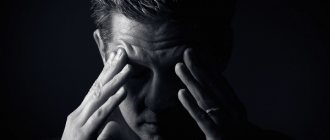Each of us has experienced symptoms of depression, when the emotional background decreases significantly and interest in favorite activities disappears. Normally, this condition does not last longer than a few days. But even prolonged seasonal depression does not cause much concern: as soon as the sun peeks out from behind the clouds, the mood immediately lifts. A completely different matter is deep depression, when neither a vacation in hot countries nor a conversation with your best friend brings the slightest bit of relief.
Causes
The disease can develop for many reasons. They are divided into three groups:
- Psychological – these include situations that greatly traumatize a person’s consciousness. They can arise abruptly, unexpectedly (death of relatives and friends, loss of large money or property, war, breakup with a loved one, criminal punishment). The event that happened literally breaks a person’s life and turns the whole way of life upside down. The psyche is not ready for the changes that have happened. A destructive factor can cause deep depression after some time of its action. The psyche of some people cannot withstand the stress of an exhausting work schedule, caring for a bedridden patient, or constant poverty. Major depression in men is most often caused by financial and career problems. For women - personal life and family troubles.
- The endogenous causes of major depression are not related to the external world. They consist of metabolic disorders, which are accompanied by an imbalance of dopamine, serotonin and adrenaline. These elements are the main mediators of the human nervous system. When their content in the body decreases, a person experiences an unreasonable bad mood and a depressed state. The peak of deep depressions caused by endogenous factors occurs in the autumn-spring period.
- Symptomatic – causes that provoke the occurrence of a pathological condition. These include serious illnesses, injuries, and medications.
Not all people develop major depression. It depends on the mental stability and individual characteristics of the person.
Etiology of the disease
The classification of depression according to the current edition of the manual of mental disorders involves division into the following groups:
- major depressive disorder;
- chronic depressive disorder;
- depressive disorder with specified or unspecified etiology: premenstrual disorders, depression due to health problems, consequences of taking psychoactive drugs.
Most cases of depression have a clear age link: adolescence or age 20-30 years. Due to mental characteristics, women are more prone to depressive symptoms; the exact reasons for this phenomenon have not yet been established. Some depressive symptoms occur in 30% of patients seeking medical help. Less than 10% of those who apply show signs of deep depression that require competent medical intervention.
The state of demoralization associated with unpleasant incidents in the patient’s life differs significantly from clinical depression. There are a number of characteristic signs indicating temporary psycho-emotional difficulties that disappear within a few days without specific treatment:
- deterioration in mood manifests itself in outbreaks and is not permanent or protracted;
- as events change, a person’s mood improves and his mental state returns to normal;
- low mood can alternate with fun and stable well-being;
- The patient does not have suicidal thoughts, feelings of self-hatred, or feelings of worthlessness.
If the patient is prone to depression due to demoralization, individual signs of major depression may be observed. But even they do not allow us to talk about a disease that requires immediate help.
Manifestation
Certain signs indicate the development of an abnormal condition. Symptoms of deep depression are represented by the following external manifestations:
- loss of strength and increased fatigue, accompanied by insomnia;
- indifference, lack of interest in one’s ordinary life and the people around him;
- constantly depressed mood.
If such signs are noticed in a person for more than two weeks and are of an increasing nature, then the help of a doctor is required. The clinical picture of major depression is supplemented by the following conditions:
- a feeling of self-doubt, the precariousness of one’s position;
- inability to concentrate and perform mental work at the same level;
- memory impairment;
- thoughts about suicide;
- feeling of guilt;
- constant doubts;
- weight loss;
- decreased sexual desire (sometimes complete frigidity and impotence are possible);
- overexcitation or excessive inhibition;
- lack of appetite;
- lack of emotion;
- violation of the self-preservation instinct.
Such manifestations of depression lead to the fact that a person loses the ability to normal socialize. He feels like a black sheep in society. He realizes that something is wrong with him.
Due to lethargy or excessive temper, the patient begins to be unable to cope with work and behaves inappropriately in a team. The pathological condition is aggravated by dismissal.
Peculiarities of thinking of depressed individuals
The depressive personality type occurs in people who are especially prone to developing depression. In most cases, they are pessimists and see the world in “black terms”.
Personalities of this type are not satisfied with themselves and those around them, no matter how much success they achieve in the social sphere. Most often, such people are introverts, reserved, difficult to make contact, and prefer solitude.
They are characterized by excessive feelings of guilt, self-doubt, fear of failure, panic states that arise during any changes, changes, or life difficulties.
Psychotic signs
Symptoms of deep depression are often accompanied by hallucinations. Disorders can be visual, auditory and even olfactory in nature. Patients often complain of hearing voices.
In addition, people who are severely depressed may suffer from delusions. Most often, a sick person says that:
- is sick with a terrible, incurable disease;
- is a terrible sinner;
- impoverished;
- guilty of fictitious crimes;
- feels that something bad will happen to him.
Psychotic symptoms are also characteristic of other disorders of consciousness. Therefore, to determine the disease, it is important to know the entire clinical picture as a whole.
Stages of pathological syndrome formation
Severe depression does not occur suddenly, but develops gradually. Stages of pathological syndrome formation:
- Negation. Outwardly, a person’s lifestyle does not change, but he experiences a severe internal conflict. The patient turns on psychological defense mechanisms based on denial of reality. It manifests itself as changes in eating behavior, psycho-emotional instability, and sudden mood swings.
- Resentment and anger. At this stage, a person begins to look for those to blame for his serious condition. Signs such as attacks of uncontrolled aggression, tearfulness, increased anxiety, and irritability appear.
- Stage 3. The patient experiences hormonal disruptions, and the production of serotonin, the pleasure hormone, decreases. A person begins to lose or rapidly gain weight, suffer from insomnia, headaches, and suffer from exacerbation of chronic pathologies.
- Last stage. It is characterized by pathological processes that destroy the physical health and psyche of a person. The patient loses control over his own behavior, the ability for adequate, rational thinking, and becomes potentially dangerous both for himself and the people around him.
Psychotic signs of major depression
Major depression can be expressed psychotically:
- hallucinations;
- obsessive states;
- denial of life's realities;
- intolerance to other people's opinions;
- hypertrophied feeling of guilt;
- panic fear;
- expectation of something terrible (fatal illness, disaster, death of loved ones).
Somatic signs of prolonged depression
Prolonged depression has somatic signs:
- heart pain;
- disturbances of heart rhythm and palpitations;
- pain in the lower abdomen;
- pain in the hypochondrium;
- prostration;
- problems with the functioning of the digestive system.
Patients complain of various painful sensations and often convince themselves of the presence of severe pathologies, but medical studies and analyzes do not reveal any physiological abnormalities in a person.
What should you be afraid of?
With a deep form of depression, a person is constantly depressed. The quality of life noticeably decreases, and the ability to fully work and rest disappears. Intellectual and motor inhibition makes it difficult to interact with other people. Emotional emptiness does not allow you to really look at yourself from the outside and assess your condition.
Since it is almost impossible to get out of deep depression on your own, during this period the patient needs urgent medical care. In its absence, the disease can develop into schizophrenia. Some develop manic-depressive psychosis.
Against the background of depression, the following may develop:
- hepatitis;
- gastrointestinal disorders;
- thyroid dysfunction;
- cardiac ischemia;
- joint pain;
- osteochondrosis.
What else is the danger of deep depression? A person may develop suicidal tendencies. Seeing the whole world in a distorted form, self-flagellation, lack of desire to find a way out, emptiness give rise to thoughts of taking one’s own life.
Consequences
The effects of major depression can be extremely devastating. One of the most terrible actions is suicide. Such thoughts appear first in such a state. Retardation appears much later. Moreover, a person may not share his thoughts with others. Those close to him do not notice for a long time that he is depressed. A suicide attempt can come as a surprise to everyone.
At the peak of depression, the patient will not be able to perform such an action. He simply doesn't have the strength for it. During the treatment process, motor activity is first restored. Only after some time is the normal emotional state restored. Thoughts about suicide do not go away immediately, but gradually. It is during the period of “exiting” and “entering” depression that people most often commit such actions. Therefore, the treatment process must begin as early as possible. It must be supervised by an experienced specialist.
Major depression: what to do?
People in this state are emotionally closed, so even relatives may not immediately understand that something is wrong with their family member. However, if a shock has occurred in a person’s life or strange behavior is noticed, it is better not to wait for severe manifestations and to visit a psychiatrist. Only a specialist will be able, having understood the reasons, to determine how to lift a patient in such a state out of deep depression.
Under no circumstances should you self-medicate, drink herbal teas, tranquilizers or go to fortune tellers. Only a psychiatrist can understand whether there really is a disease and how to cure it.
Frequently asked questions about depression
How to get rid of depression on your own?
Attempts to deal with depression on your own usually end in failure and the appearance of signs of a deeper disorder. Only an experienced doctor will be able to determine the type of disease and select the optimal treatment tactics. Folk remedies, uncontrolled use of antidepressants “on the advice of friends,” withdrawal into oneself only tighten the problem and can cause deeper mental disorders with a simultaneous deterioration in physical health.
Why is depression dangerous?
Voluntary refusal of treatment with the intention of independently overcoming the disease can have the most severe consequences: the appearance of suicidal thoughts, deep mental disorders, increased frequency of attacks, personal degradation in professional and family terms, and the emergence of addiction to alcohol and drugs. It is useless to treat all of these symptoms with conventional treatment methods, and taking potent drugs can cause side effects.
Diagnostics
The doctor determines the presence of major depression by interviewing (special tests are used) and observing the patient. The symptoms and treatment of major depression are inextricably linked.
If a specialist is confused by any atypical manifestations of the disease, he will refer the patient for additional examinations to other doctors:
- to a cardiologist - to confirm or exclude diseases of the cardiovascular system;
- to a neurologist to examine the brain (in this case, a cardiogram or MRI may be prescribed).
Fear in depression
Fear is a persistent symptom of depression. Anxiety can have varying degrees of severity (from mild fear to panic attacks). Patients often “feel fear” in the area of the heart or abdomen. No clear cause has been found for its occurrence. Accompanies patients throughout the entire period of illness.
Less common symptoms of depression include:
- dysphoria (a fairly common phenomenon, manifested by impatience, irritation, anger, and is often a source of self-harm and suicide attempts);
- so-called “depressive judgments” - belong to thinking disorders; manifested by a negative opinion about oneself, one’s future, health and behavior; patients are pessimistic about both their current situation and prospects in life;
- obsessive thoughts or actions (constant thoughts appear against the will of the patient, and there is also a desire to repeat any actions);
- dysfunction in a social group (family, workplace) - as a rule, due to a decrease in interest in the outside world; they can lead to a complete severance of contact with the environment;
- feeling of constant fatigue.
The process of depression occurs differently in individual patients. The severity of symptoms varies significantly from patient to patient. Age also plays an important role: in young people depression often proceeds smoothly, but in later life the disease gains strength. A depressive episode can last for varying lengths of time, from a few days to several weeks, months, or even years.
Pharmacotherapy
The most effective method used to treat major depression is medication. Antidepressants are used for this. The choice of medications depends on the condition and age of the patient, as well as the manifestations of the disease.
The most commonly used antidepressant drugs are:
- with noradrenergic action (“Mianserin”);
- inhibitors whose action is based on the reuptake of serotonin (Fluvoxamine, Sertraline);
- tetracyclic series (Imipramine, Amitriptyline).
If deep depression is accompanied by anxiety, parallel use of tranquilizers is prescribed. Psychosomatic symptoms are relieved with antipsychotics.
At the discretion of the doctor, therapy is carried out on an outpatient basis or at home. In the presence of suicidal signs, treatment is carried out only in a hospital.
Treatment
When diagnosing deep depression, the doctor prescribes a set of procedures and medications to the patient. Therapy includes the use of medications, exercise therapy, psychotherapy, hypnosis and physical therapy.
The doctor prescribes tricyclic antidepressants, selective inhibitors, as well as drugs with specific noradrenergic effects. Tranquilizers may be prescribed. In the presence of psychotic symptoms, the course is supplemented with short-term use of antipsychotics. Under the supervision of qualified specialists, recovery from depression will occur quickly.
Having considered the features of such a condition as severe depression, we can note the urgent need for its treatment under the supervision of an experienced specialist. Self-healing in this case is unlikely.
Psychotherapy
Treatment of major depression in women and men is not limited to taking medications. Psychotherapists conduct conversations with the patient. Various techniques are used in individual sessions:
- cognitive-behavioral correction;
- suggestion;
- belief.
Psychotherapy is aimed at changing the patient's attitude towards the problem that caused deep depression. The patient must learn to live with what happened and cope with the situation.
At the final stages of treatment, group and family therapy gives good results. After recovery, the doctor advises the patient about auto-training. They must be used by the patient throughout his life.
Symptoms
Major depression is characterized by a whole range of pronounced symptoms.
Having understood that the state of deep depression is a dangerous disease, you should know how it manifests itself. In general, there is no difference between major depression and major depressive disorder or clinical depression. Major depression has the same symptoms, but they are more severe.
The term “major depression” does not describe a specific type of depressive disorder, but rather the severity of the symptoms and manifestations of a mental disorder.
With major depression, the main symptoms are:
- depressed mood;
- prostration;
- decreased performance;
- inability to enjoy life;
- feeling of anxiety;
- feeling of worthlessness;
- exacerbation of phobias;
- thinking disorder;
- physical illness;
- sleep disorders;
- change in appetite.
The severity of certain symptoms depends on the form of major depression. Thus, with the anxious form, phobic disorders, panic attacks and a constant feeling of anxiety come to the fore. At the same time, the patient complains of a constantly bad mood, sees the world in dark colors, and is pessimistic. In other forms of depression, anxiety may be present, but less severe.
The main signs and manifestations of deep depression are a constantly depressed mood. The patient is not able to feel joy, interest, curiosity, admiration and experience other emotions characteristic of healthy people. At the same time, motivation for any activity is lost, which leads to a noticeable decrease in performance. Quite often, patients with major depression simply stop working professionally, preferring to spend time at home and consciously choosing social isolation.
Major depression is accompanied by a number of mental symptoms. As a rule, many patients are faced with an inferiority complex, considering themselves inferior to everyone else. Depressive disorder is characterized by a pathological feeling of guilt, which is aggravated by a lack of motivation. Quite often, patients demonstrate a tendency to self-flagellation and feel their own worthlessness. Over time, such thoughts lead to suicide attempts.
Impaired thinking in depression is manifested by a deterioration in the ability to concentrate and remember new information. Patients with major depression lose the ability to learn new skills. Changes also affect the speech of patients, their voice becomes monotonous and devoid of emotional coloring, facial expressions become poorer, and gesticulation is almost completely absent.
Deep depression may be accompanied by physical illness - headache, imaginary pain in the back and limbs, a feeling of pressure in the chest and pain in the heart.
Deep depression in men is often accompanied by a feeling of worthlessness and insolvency, weakening of sexual function, up to the development of psychogenic impotence. Deep depression in women often manifests itself as constant depression, loss of interest in life, and neglect of one’s appearance.
Deep depression is always accompanied by sleep disturbances. This may manifest itself as insomnia at night and constant sleepiness during the day. If asthenic symptoms predominate, a person spends a lot of time sleeping, but still feels constantly tired.
How to suspect major depression: 5 main symptoms
Sleep problems indicate symptoms of major depression
Symptoms and treatment of major depression depend on how quickly the patient notices the emotional decline and consults a doctor. The problem with this disorder is that people become so accustomed to their condition that they do not consider a constantly depressed mood a sign of depression and prefer not to seek qualified help. At the same time, deep depression is dangerous due to its chronic course, and therefore requires timely medical attention.
The main symptoms indicating that the psyche needs help:
- constantly depressed mood;
- problems falling asleep, nightmares, feeling groggy in the morning;
- feeling of constant fatigue;
- loss of life guidelines;
- tendency to isolate.
Doctors include a sudden decrease in sexual desire among non-obvious symptoms of depression.
Major depression is clinical depression multiplied by two. In fact, the features of deep depression in women and the signs of this disorder in men are the same, but in the fairer sex the pathology occurs three times more often.
Electroconvulsive therapy
Patients with major depression do not always respond to therapeutic treatment. In this case, doctors use a more radical remedy - electroconvulsive therapy. It involves exposing the patient to electrical discharges.
The procedure goes as follows:
- The patient is given an anesthetic.
- Electrodes are applied to the temples.
- The current causes a seizure that lasts up to one minute.
To avoid complications, a complete examination of the patient is carried out before the procedure. The course lasts from ten to sixteen sessions. Positive changes begin after the first of them.
Circadian rhythm disturbances in depression
One of the most serious somatic symptoms of depression is a violation of the body's biological rhythm. Rhythm is a natural biological timer that regulates the normal functioning of the body. Problems associated with circadian rhythm disturbances destroy both the body and the psyche.
Often depression...
In healthy people, the feeling of the need for sleep and wakefulness is regulated without the participation of consciousness, by internal brain centers. In depression, there are two types of circadian rhythm disturbances.
In the first, there is a reduction and deterioration in night sleep. The patient may wake up easily and have difficulty returning to sleep. The duration of sleep is shorter than usual, the patient gets up very early in the morning. The amount of sleep is not enough for normal regeneration of the body. The problem of insomnia is common in patients with depression.
Another type of sleep disorder is sleep deficiency. Characterized by an increase in drowsiness and sleep duration. This somatic disorder is primarily associated with increased sleep at night. In addition, drowsiness appears during the day.
Changes in sleep patterns disrupt the daily life of a person suffering from depression. Along with them, daily mood swings . It worsens significantly in the morning, and is better in the afternoon and evening. Problems with falling asleep and lack of continuity of sleep (waking up at night) affect the patient’s well-being.
Physical exercise
When a patient begins to emerge from a state of deep depression, his independent participation in the recovery process is very useful. For this, the doctor prescribes physical exercises.
Active movements affect muscle tone and force the body to produce endorphins. These substances act in the same way as antidepressants. In addition, the patient begins to feel control over his body. This makes it possible to regain self-confidence.
Physical exercise must be performed regularly. Ideally, fifteen minutes every day.
Folk remedies
At home, you can easily cope with some symptoms using traditional medicine. Many recipes suppress sadness, improve the functioning of the nervous system and stimulate the production of joy hormones. They should be used in moderation after consulting a doctor.
One of the most popular folk remedies is warm baths with the addition of beneficial substances. It is best to take them in the morning or late evening. It is enough to add a little of the chosen product to a bath filled with warm water and lie in it for half an hour. Essential oils of lemon, lavender and rosemary, juniper, spruce needles, natural honey, myrtle petals, and infusion of poplar buds are especially effective.
Regular massages are highly effective. Carrying them out on your own can be difficult, but if desired, it is quite doable. You just need to massage your body with light, pleasant movements, lubricating your hands with essential oils that have a calming effect.
You can also get rid of prolonged depression with the help of tinctures or decoctions. They should be taken before meals or before bed. Ginseng root, Eleutherococcus, and Rhodiola rosea are considered very useful. Preparations based on Chinese lemongrass, aralia, mint, valerian, lemon balm, hops, motherwort, lavender and peony are no less effective.
Additional measures
When treating major depression, it is important not only to accurately take all medications prescribed by your doctor, but also to follow his other recommendations. These include:
- proper rest (sleep at least eight hours a day);
- balanced meals at the same time;
- daily walks along the street, trips to nature;
- exercise, swimming, play sports.
You need to monitor the amount of sweets you eat. During deep depression, their number goes off scale, and this can cause the development of diabetes.
Alcohol must be completely eliminated from the diet. Its use is strictly prohibited while taking antidepressants, since their combination can cause severe side effects. In addition, alcoholic drinks greatly aggravate the patient's condition. Against the background of a hangover, depression only strengthens and develops faster and stronger.
It is very good if, during the progression of the disease, there is a close person next to the patient who makes decisions for him. Indeed, with deep depression, the patient becomes apathetic, he is not able to set priorities and identify important moments in life.
Severe depression and suicide
Severe depression is dangerous because the patient completely loses the instinct of self-preservation. A persistent feeling of melancholy, as well as constant pain tormenting his soul, makes him think about suicide. An overwhelming feeling of guilt, a feeling that he deserves punishment, a desire to free his loved ones, often push a person to commit suicide. According to statistics, 15% of people with mental disorders of unknown etymology become victims of suicide.
At the onset of the disease, the person is so weak, exhausted by severe depression, that he is unable to take any steps to take his own life. But as soon as this condition goes away, the patient may attempt to commit suicide. He will think through the suicide plan in detail, develop it, and try to create a deceptive impression that he has gotten better, without leaving the thought of committing suicide.
The most common cases of suicide are among lonely people with a history of somatic illnesses and people with a history of suicide in their family.
What should a person do if he has all the signs of severe depression? There is only one answer to this question: seek help immediately. If depression is not treated, it will become chronic, and this is fraught with very dangerous consequences.
Prevention
After exiting the pathological state, it is necessary to take all measures to ensure that emotional stability is maintained. To do this you need:
- exclude unpleasant people who cause negativity from your social circle;
- develop supportive relationships;
- lead a socially active lifestyle;
- maintain a sleep schedule;
- master relaxation techniques;
- improve relationships with loved ones;
- fight bouts of negative thinking;
- avoid stress, breakdowns, hysterical attacks;
- lead a healthy lifestyle;
- take care of yourself;
- get an animal;
- hike;
- find a hobby.
If, despite following all the recommendations, the pathological condition returns, do not hesitate to contact a specialist. Needing help does not indicate weakness or worthlessness. Various situations in life cause severe damage to the psyche, and the body cannot always cope with severe depression the first time. Providing timely medical care will help get rid of the abnormal condition and return to a normal, fulfilling life.
Early symptoms
Is it possible to determine exactly when a banal bad mood or an episodic case of overwork turned into the development of depression? Doctors are not always able to identify the moment when the disease debuted. However, there are its characteristic features from which the formation of pathology begins. These features appear blurred or more clearly, isolated from each other, one after another or simultaneously.
Psychologists and psychotherapists recommend paying attention to the appearance of early signs of depression, and remember that some of the listed symptoms may be manifestations of other pathologies of a physiological or mental nature.
Content:
- Early symptoms
- Manifestation of depression of various forms
- Behavior and appearance of people suffering from depression
- How to recognize the condition in yourself
- Signs of recovery from depression
Thus, a person may suddenly be alerted by the appearance of inexplicable fatigue and exhaustion, a feeling of loss and lack of vital energy. Against this background, there is an increased need for rest. To perform normal daily activities, such as going to work or school, a person has to make an effort every day.
Depressed mood and depression are combined with a sharp decrease in self-esteem, the emergence of doubts about oneself and one’s own strengths. The patient feels preoccupied with problems and adversity; the surrounding reality causes fear of the future. Ordinary interests fade into the background, fade and cause much less passion than before. A person shows inattention to everyday affairs and everyday issues; it is more difficult for him to concentrate on work and his responsibilities. Mental work is more difficult than usual. Mental reactions undergo significant changes, the effect of peripheral stimuli on the alpha rhythm of the brain weakens.
Due to problems with self-esteem, increased suspiciousness manifests itself, the feeling that a person is being discussed and judged behind his back. The patient attributes all the problems that happen to him and his loved ones to his own account, takes the blame for them upon himself, and in general becomes more prone to self-flagellation.
Against the background of changes in perception and behavior, a person’s daily routine and usual schedule changes, and sleep takes up most of his free time. To relieve the resulting tension, the affected person turns to alcohol, tobacco, and junk food.
How does depression manifest itself?
Story one: Alice
Alice first turned to a psychiatrist in her fourth year at the institute. According to the girl, by that time she had already been depressed for several years. “It all started when I was thirteen. I have always been a cheerful and open child. But then everything changed. I withdrew into myself, and every year this condition worsened.”
By the age of eighteen, Alice could hardly speak, feel or show emotions. Her first love completely knocked her down - the young man regularly raised his hand to the girl.
“I went to study in another city, hoping that it would become easier. It's gone. My parents hardly noticed anything, and I couldn’t even tell them what was happening. One day I just went into the forest all night. I screamed, cried... I didn’t care what happened to me. Fortunately, it worked out.”
One day I just went into the forest all night. I didn't care what happened to me
Alice was getting worse. In the student dormitory she did not communicate with anyone, did not want anything, and studied mechanically. Personal relationships did not work out.
“Nothing touched or worried me. I suffered from loneliness and lack of meaning in life. I tried several times to get a job. At the interview they told me that I was a drug addict, I looked so bad.”
Story two: Catherine
In the spring of 2021, Katya felt that there was no room left for her in her life. “I existed only for work, a child, a mother and a dog. And I was so tired of it that I couldn’t do anything at all. I had difficulty waking up, lay in bed all day and cried constantly. There was no money for a paid specialist, so I turned to the nearest psychoneurological clinic.”
How is depression treated?
The drugs prescribed for Alice did not help. “They managed to stabilize me a little. I even got a job. And at the age of 26 it became so bad again that drugs appeared. I barely got down. Psychiatrists, learning about my suicide attempts, suggested that I go to a hospital. I refused. It took several years to find a specialist willing to treat me without putting me in a ward, and then a little over two more years to find a treatment regimen.”
For Katya, everything turned out differently. In the fall of 2021, she was admitted to one of the IPCs in her native Novgorod for two weeks. “It was terrible. I was prescribed pills again. We were all in the same department - people with depression, drug addicts, alcoholics, old grandmothers with dementia. The nurses treated us like... I don’t even know how to say it. I will never forget one grandmother. She felt very bad, and they constantly yelled at her and intimidated her. They had a clear directive: we all needed to be calmed down and calmed down. That's all."
According to the girl, she left the hospital with one thought: never agree to be hospitalized again. But, on the other hand, this experience nevertheless brought Katya back to life. Dire impressions forced her to look for any ways to support herself and not succumb to depression.
“For somatogenic or endogenous depression, drug therapy is recommended,” comments Elena Beletskaya. “This is the most effective, because the root of the problem is congenital disorders of the functioning of brain transmitters. For psychogenic, neurotic, reactive and masked depression, medications are best combined with psychotherapy. The success of treatment here depends on what became the provoking factor. If this is an isolated episode, then you can simply undergo a course of treatment; if it is a personal factor, then you will have to develop a life strategy taking into account your personality characteristics.”
“It is worth seeking help in any available place and in any available way. A psychologist is often an intermediate link between a patient and a psychiatrist and relieves anxiety several hours before a person decides to go to the doctor,” explains Beletskaya.
Depression test
Timely and adequate diagnosis of depression is the prerogative of professional psychologists and psychiatrists. In clinical practice, various types of depression tests are used to identify this disease.
- The Beck scale was proposed back in 1961 by Aaron Temkin-Beck, a professor of psychiatry at the University of Pennsylvania. The test reveals both the cognitive-affective scale and the scale of somatic manifestations of depression. The questionnaire contains 21 questions containing various symptoms and complaints. They are ranked according to the degree of significance as part of the signs of classical depression. There are 4-5 possible answer choices depending on the severity or severity of the symptom. The test results are presented as a sum of points:
- 00-13 points – within normal limits;
- 14-19 – mild depression;
- 20-28 – moderate depression;
- 29-63 - severe depression.
- 20-49 corresponds to the norm;
- 50-59 within mild depression;
- 60-69 suggest moderate depression;
- over 70 – severe depression.
- 00-07 corresponds to the generally accepted standard;
- 08-31 – mild depressive disorder;
- 14 -18 – moderate severity disorder;
- 19-22 reflects a severe degree;
- Exceeding 23 points corresponds to an extremely severe disorder.
In addition to testing for the type and severity of depression, the patient undergoes a number of studies:
- Clinical and anamnestic examinations to make an accurate diagnosis of the disease;
- Pathopsychological studies assessing the emotional-volitional sphere of the patient and the state of the processes of higher nervous activity;
- Somatic studies aimed at identifying trigger diseases and associated pathologies;
- Laboratory and instrumental studies to exclude other diseases, for example, schizophrenia.











